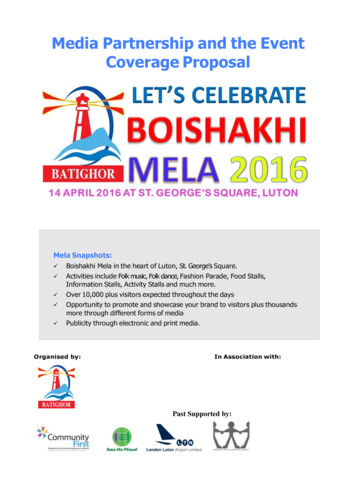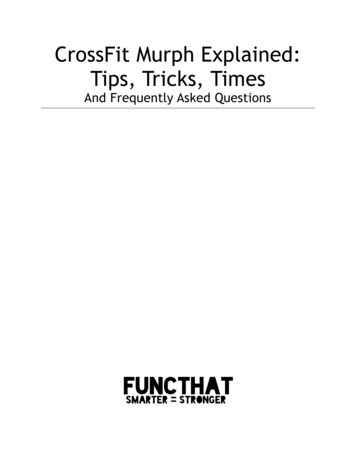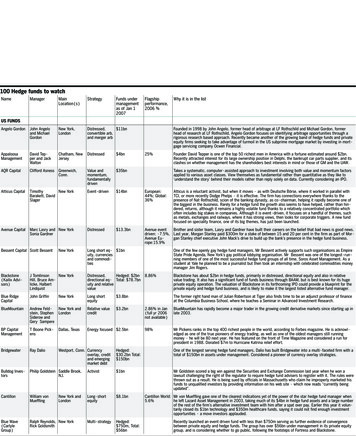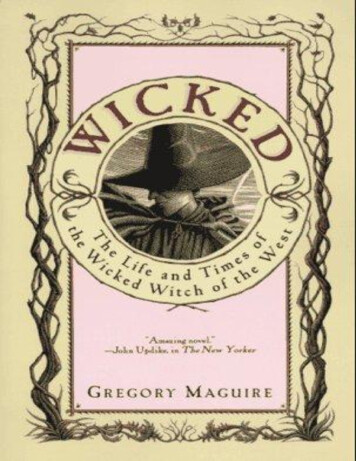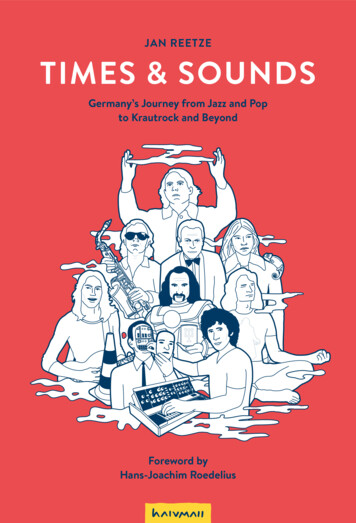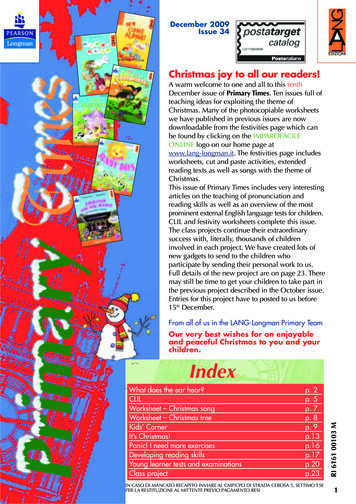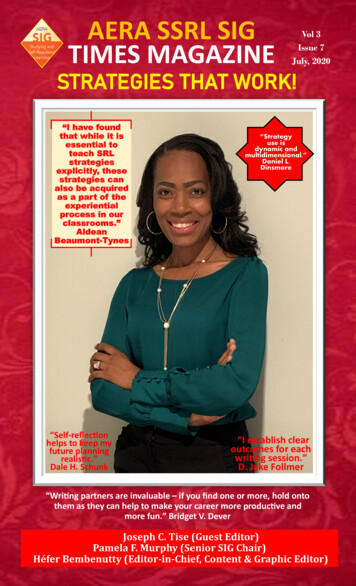
Transcription
Submitted draft to Expert Systems With Applications (ESWA).Published paper: 0957417412006100Junqué de Fortuny, E., De Smedt, T., Martens, D., Daelemans, W. Media coverage in times of political crisis: A textmining approach. Expert Systems with Applications (2012).Media coverage in times of political crisis:a text mining approachEnric Junqué de Fortuny Tom De SmedtFaculty of Applied EconomicsFaculty of ArtsUniversity of Antwerp, BelgiumUniversity of Antwerp, BelgiumDavid MartensWalter DaelemansFaculty of Applied EconomicsFaculty of ArtsUniversity of Antwerp, BelgiumUniversity of Antwerp, BelgiumFebruary 1, 2012AbstractAt the year end of 2011 Belgium formed a government, after aworld record breaking period of 541 days of negotiations. We havegathered and analysed 68, 000 related on-line news articles publishedin 2011 in Flemish newspapers. These articles were analysed by acustom-built expert system. The results of our text mining analysesshow interesting differences in media coverage and votes for severalpolitical parties and politicians. With opinion mining, we are able toautomatically detect the sentiment of each article, thereby allowingto visualize how the tone of reporting evolved throughout the year,on a party, politician and newspaper level. Our suggested frameworkintroduces a generic text mining approach to analyse media coverageon political issues, including a set of methodological guidelines, evaluation metrics, as well as open source opinion mining tools. Since allanalyses are based on automated text mining algorithms, an objectiveoverview of the manner of reporting is provided. The analysis showspeaks of positive and negative sentiments during key moments in thenegotiation process. Corresponding author, enric.junquedefortuny@ua.ac.be1
1IntroductionBelgium has recently recovered from the longest government formation period known to modern-day democratic systems (BBC Europe, 2011). It iswell established that mass media and the internet in particular play an increasingly more important role in opinion formation (Savigny, 2002). On-linearticles are easily accessible, providing us the unique opportunity to access,analyse and compare them over different newspapers. With huge amountsof articles available, it is no longer possible to analyse and interpret themmanually. This challenge is overcome by using a text mining approach, whichallows for automated analysis of all the articles. Using an automated technique strengthens the objectivity of the analysis: personal bias and opinionin scoring is reduced substantially due to the absence of manual human intervention. Please note that we refrained from interpreting the results on apolitical level as much as possible, yet we write to demonstrate how a textmining approach allows an efficient and objective analysis and to summarizenews coverage in today’s on-line media landscape.1.1The role of mass media in opinion formationNowadays, news papers and other news providers are updating their on-linenews feeds in near real-time, allowing interested parties to follow the newsin near real-time. The Internet has thereby become an important broadcastmedium for politicians.A study by Benewick et al. (1969) showed that high exposure to a party’sbroadcasts was positively related to a more favourable attitude towards thatparty for those with medium or weak motivation to follow the campaign.Knowing this, McCombs & Shaw (1972) raise the question whether the massmedia sources actually reproduce the political world perfectly. In an imperfect setting, biases of media could propagate to the public opinion andtherefore influence favouritism towards one or another party or politician,thus shaping political reality. Most of this bias is introduced by the editingand selection process. They conclude that the mass media may well set theagenda of political campaigns. In the digital era, Internet has taken up itsown place as a mass medium next to TV (Fredricksen, 2010) and the aforementioned concerns are becoming increasingly more relevant for the Internetas well.In a meta-analysis considering 59 studies D’Alessio & Allen (2000) found2
three main bias metrics used to study partisan media bias. The first biasmetric is derived of the fact that mere selection (and deselection) of news articles to be published by editors introduces a bias. This so called gatekeepingbias causes some topics to never surface in the media landscape and is therefore an interesting measure of a sampling bias, introduced by editors andjournalists (Dexter & White, 1964). The problem when measuring the gatekeeping bias, however, is that it assumes knowledge of the whole universe ofarticles before actual selection. This turns out to be infeasible to determinefor our purpose since information about rejection is generally undocumentedand thus unknown.A second bias metric considered, is the coverage bias, which measures thephysical amount of coverage that each side of the issue receives. Traditionally,this is measured in column inches, amount of headlines or in broadcasts timedevoted to sides of the issue. We measure the coverage as the amount ofon-line articles. For political issues each party or politician can be seen asa ‘side’ or an entity. We argue that fair coverage is determined by an apriori distribution. This a priori distribution represents all entities in thepopulation by their relative importance as measured by electoral votes in thelast elections. Large deviations from the fair distribution tend to show somecoverage bias towards one or another entity.Third, there is the statement bias metric which is concerned with the distinction between favourable versus unfavourable or positive versus negativenews. Given the large corpus used in this study, we choose an automated sentiment mining approach to measure the statement bias. A word of caution isin order about the interpretation of these ’sentiments’ in news articles. Whenan article about an entity is classified as negative, this does not necessarilyimply unfavouritism from a news source or journalist towards that entity. Itmight be that the entity is purposely interjecting negative criticism in thearticle. This measure should therefore be seen as an associative measure(i.e. a party is associated with a negative image when most of its coveragecontains negative content). No conclusions can be made as to whether thisimage is build by the entity in question or by the news source, that is, wecan only prove that it exists.Belgium has seen a unique governmental crisis in 2007-2011 during whichboth political parties and politicians have had wide media coverage. In thisstudy, we analyse the bias towards political entities during this period usinga text mining approach. In order to do so, we must first elaborate on theunique setting in which this study took place.3
PartyCD&VIdeologychristian democraticN-VAFlemish nationalism, liberalconservatismliberalism, social liberalism,market liberalismsocial democracy, third wayOpen VLDSP.AVBFlemish nationalism,ratism, conservatismsepa-Political figuresM. ThyssenR. TorfsJ.-L. DehaeneE. SchouppeS. de BethuneP. Van RompuyB. WeverH. StevensA. de CrooD. SterckxJ. Vande LanotteF. VandenbrouckeM. TemmermanF.DewinterTable 1: Flemish parties included in the corpus.1.2Belgium and its unique political crisisAt the basis of the Belgian crisis lies its dual federalist structure (the twomajor regions being the Dutch speaking Flemish Community and the FrenchSpeaking French Community). An overview of the political parties, includingtheir ideology and their prominent figures is displayed in Table 1.The mass media has played an important and sometimes controversialrole in the courses taken by parties and - as is often the case in politicalconflicts - passionate assertions have been expressed towards the mass mediaand its favouritism (Niven, 2003). The question whether there truly existsa bias or not should however be answered by a systematic analysis. Weaccomplish this through the different bias metrics introduced in Section 1.1.Using text mining techniques we can calculate these metrics in an unbiasedway, a rare feat in a political setting. Comparison with the actual electionoutcomes allows us to extrapolate information on the relative biases of massmedia towards one or another party.We use the 2010 Chamber election results as a golden standard againstwhich we measure the mass media bias. The reasoning behind this choiceis that the mass media know these results and therefore know the relative4
weights of different political parties beforehand. A similar reasoning is used tocompare politicians, but using the 2010 Senate election results since popularpoliticians are voted for directly in the Senate elections, whereas Chamberelections concern party votes.1.3Text mining and sentiment analysisThe information age offers an overwhelming number of text documents available on the Web and elsewhere. This poses a challenge since the amount ofinformation is constantly increasing. Furthermore, text documents generally lack metadata such as language, topic, syntactic structure and semanticlabels.Text mining or knowledge discovery concerns the process of automatically extracting novel, non-trivial information from unstructured text documents (Fayyad & Piatetsky-Shapiro, 1996), by combining techniques fromdata mining, machine learning, natural language processing (NLP), information retrieval (IR) and knowledge management (Mihalcea, 2011). Commontext mining tasks involve document classification, summarization, clustering of similar documents, concept extraction and sentiment analysis. Textmining has had a wide range of applications to date, prevalent applicationsinclude: forecasting petitions (Suh et al., 2010), guiding financial investments(Rada, 2008) and sentiment detection in reviews (Tang et al., 2009).Textual information can be broadly categorized into two types: objective facts and subjective opinions (Liu, 2010). Opinions carry people’s sentiments, appraisals and feelings toward the world. Sentiment analysis (oropinion mining) is a subfield of natural language processing that in its moremature work focuses on two main approaches. The first approach is based onsubjectivity lexicons (Taboada et al., 2011), dictionaries of words associatedwith a positive or negative sentiment score (“polarity”). Such lexicons can beused to classify phrases, sentences or documents as subjective or objective,positive or negative. The second approach is by using machine learning textclassification (see for example Pang et al. (2002)). Most work on sentimentanalysis has been carried out on product reviews.News sources are sentiment-rich resources for which we can extract qualitative information using similar techniques as described above. Using asubjectivity lexicon for Dutch adjectives we analyse the general tone associated with politicians and their parties during the political crisis. Similarresearch has been conducted by Schumaker & Chen (2009) for stock market5
SelectionPreprocessingData MiningEvaluationInterpretationComparePolitical AnalysisExtractsentimentsMedia SourceCrawlRemoveDuplicatesExtractcoverageKeyword DictionaryElection ResultsFigure 1: Processing steps used to build and analyse the corpus.prediction, Godbole & Skiena (2007) for news and blogs and Balahur et al.(2010) for newspaper articles.2Material and methodologyIn our analyses, we followed the KDD methodology (knowledge discovery indatabases) by Fayyad & Piatetsky-Shapiro (1996) that describes the differentsteps in a KDD application. The resulting process as applied to our problemis displayed in Figure 1.2.1Data acquisition and selectionThe corpus used in this study comprises of all articles published in on-lineversions of all major Flemish newspapers in 2011 until the end of the politicalcrisis. The corpus contains over 68, 000 articles, spanning a ten month period(from January 1, 2011 to October 31, 2011). An overview of the eight coverednewspapers is displayed in Table 2.All articles were gathered using a custom built web-crawler. The crawlerextracts articles from the sources’ websites using their built-in search functionalities. The crawling process is the equivalent of a typical database selection process in which relevant data are selected using the given query criteria.The query keywords are all major Flemish party names and leading figuresof political parties (see Table 1). The criterion for being a party of interestis based on the votes for that party in the 2010 Chamber Elections, we onlyincluded major parties who were allowed in the Chamber (i.e. parties withat least one chair). A leading figure is a politician with a top ten ranking6
amount of preference votes in the 2010 Senate Elections (cf. Section 1.2). Anoverview of all political entities included in this study is displayed in Table 1.2.2Data PreprocessingIn a second preprocessing phase all data is filtered so as to remove possibleduplicate articles. To see why this is necessary, consider the case in whichan article concerns two parties at the same time. As a consequence of thecrawling process, this article will be presented twice in the dataset (once forthe first party name search, once for the second party name search). Thesecond article present is a redundant entry and must be removed for thefrequency information to be correct. This leaves us with a corpus of allunique articles containing the keywords presented in Table 1.2.3Data Mining: Sentiment analysisFor sentiment analysis, we used the previously created Pattern mining module for Python1 . The module contains a subjectivity lexicon of over 3, 000Dutch adjectives that occur frequently in product reviews, manually annotated with scores for polarity (positive or negative between 1.0 and 1.0)and subjectivity (objective or subjective between 0.0 and 1.0). For example: “boeiend” (fascinating) has a positive polarity of 0.9 and “belabberd”(lousy) has a negative polarity of 0.6. A similar approach with one axisfor polarity and one for subjectivity is used by Esuli & Sebastiani (2006) forEnglish words.In previous research, the lexicon was tested with a set of 2, 000 Dutchbook reviews. Each review also has a user-given star rating. The set wasevenly distributed over negative opinion (star rating 1 and 2) and positiveopinion (star rating 4 and 5). The average score of adjectives in each reviewwas then compared to the original star rating, with a precision of 72% and arecall of 82% (De Smedt & Daelemans, 2011).In our approach, we look for occurrences of Flemish political parties (seeTable 1) in each newspaper article. We then calculate the polarity of eachadjective that occurs in a window of two sentences before and two sentencesafter. An article can mention several party names, or switch tone. The given1http://www.clips.ua.ac.be/pages/pattern7
interval ensures a more reliable correlation between the political party being mentioned (the “target”) and the adjective’s polarity score, contrary tomeasuring all adjectives in the article. A similar approach for target identification with a 10-word window is used in Balahur et al. (2010). They reportimproved accuracy when compared to measuring all words in the article. Wefurthermore exclude adjectives that score between 0.1 and 0.1 to reducenoise. This results in a set of 366, 613 assessments, where one assessmentcorresponds to an adjective score linked to a party or politician.For example:Bart De Wever ( N-VA) verwijt de Franstalige krant Le Soir dat ze aanzettot haat, omdat zij een opiniestuk publiceerde over de Vlaamse wooncodemet daarbij een foto van een Nigeriaans massagraf. De hoofdredactrice legtuit waarom ze De Wever in zijn segregatiezucht hard zal blijven bestrijden.“Verontwaardigd? Ja, we zijn eerst en boven alles verontwaardigd.”Bart De Wever ( N-VA) accuses the French newspaper Le Soir of incitinghatred after they published an opinion piece on the Flemish housing code together with a picture of a Nigerian mass grave. The editor explains why theywill continue to fight De Wever’s love of segregation hard. “Outraged? Yes,we are first and above all outraged.”The adjective “hard” scores -0.03 and is excluded. The adjective “verontwaardigd” (outraged, indignant) scores -0.4. In overall, the passage aboutthe political party N-VA is assessed as negative.3ResultsWe analyse the biases and sentiments throughout the whole corpus for eachpolitical entity. We will first be looking at the frequency of occurrence (i.e.the coverage) and afterwards at the tone of articles.3.1Media coverage bias2Source: Federal Public Services Home Affairs (http://polling2010.belgium.be/. Allpercentages in this study are normalized over the Flemish parties and the selection, so as8
SourceDe RedactieDe MorgenGVAHBVLNieuwsbladDe StandaardDe TijdHLNRegional #Articles #Readers2 dH,c 0064Yes3,511423,70035No7,320 80 %22.71%21.62%Table 2: News sources used for the analysis including their respective number of articles and readers as well as bias metric values for the hammingdistance from consensus (dH,c ), the hamming distance from votes (dH,v ) andthe deviation from election outcomes (bias).The coverage c(e, s) of an entity e by a newspaper s is defined as the numberof news articles published by the newspaper on that entity, normalized onthe total amount of articles by that newspaper in the corpus As :c(e, s) # {a a As e a}#As(1)The popularity p(e) of a political party e is defined as the relative amountof preference votes v(e) for that entity (as compared to other entities in thetop ranking set E):v(e)Pv(e0 )p(e) (2)e0 EThe popularity is used as the a priori fair distribution. The coverage bias(henceforth referred to as the bias) of a media source is the difference betweenthe real distribution and the fair distribution. That is:bias(e, s) c(e, s) p(e)Xbias(s) bias(e, s)(3)(4)e Ewhere a is an article, represented as a bag of words {w1 , w2 , ., wna } with nathe amount of words in the article. Figure 2 shows that for some parties ato be able to make statistically sound comparisons.9
substantial bias is found, with a maximal positive bias towards CD&V and amaximal negative bias towards the far-right Vlaams Belang (VB ). The firstresult can be justified by the fact that CD&V ran the interim governmentwhile the new government formations took place. The latter result givessupportive evidence to previous research outcomes that the party is beingquarantined by the media (Yperman, 2004).Figure 2: Discrepancy between media coverage and popularity for popularpartiesWe repeat the analysis for politicians, using the relative amount of preference votes for a party in 2010 as a comparison measure. As can be seen inFigure 3, the bias with respect to a politician varies irrespective of the partyfrom which the politician comes. For instance, a positive bias towards BartDe Wever is not reflected in the (negative) bias of his party (N-VA).It is also interesting to note the differences between different news sources.To this extent we define a matrix, ranking all political parties by coverageper newspaper (Figure 4(a)). The major tendencies are similar to our previous analysis, but some local differences do exist. We use the Hammingdistance dH (Equation 5) to measure the amount of ranking difference foreach newspaper, compared to the average ranking (see Table 2, dH,c ). As theHamming distance increases, disagreement between the consensus rankingincreases. A maximal Hamming distance of 6 is found for regional newspaper GVA. When we look at the total bias of news papers (Equation 4), we10
Figure 3: Discrepancy between media coverage and popularity for popularpoliticianssee that again regional newspapers (GVA, HBVL) deviate more than globalo
introduces a generic text mining approach to analyse media coverage on political issues, including a set of methodological guidelines, eval-uation metrics, as well as open source opinion mining tools. Since all analyses are based on automated text mining algorithms, an objective overview o

